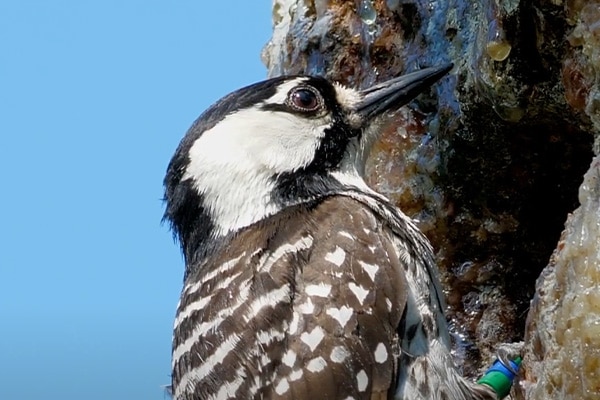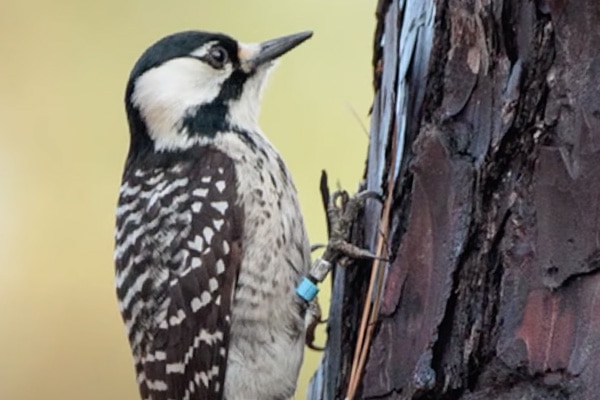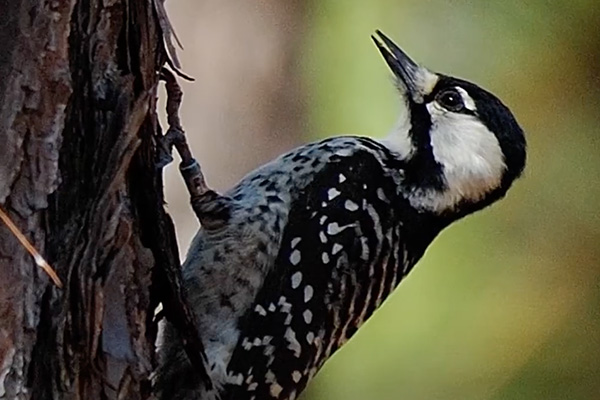Contents
- Red-cockaded woodpecker facts
- Red-cockaded woodpecker: how-to identify
- Where You’ll See Red-cockaded Woodpeckers
- Red-cockaded woodpecker diet
- Red-cockaded woodpecker nesting
- Red-cockaded woodpecker behavior
- How-to attract red-cockaded woodpeckers
- Red-cockaded woodpecker threats
- Red-cockaded woodpecker fun & interesting facts
- Red-cockaded woodpecker related species in this family
Red-cockaded Woodpeckers are small woodpeckers known to excavate exclusively in living pine trees. For this reason, the disappearance of many pine trees caused its tremendous decline, which led to these birds becoming rare and endangered local bird species.
In this article, we will learn more about the Red-cockaded Woodpecker. We’ll discuss:
- How to identify them
- Where you’ll find them
- What they eat
- How they nest
- Their behaviors
- How to attract them
- Their conservation status
- Interesting facts
So if you want to learn more about these birds, read on as we go through all bird facts…

Red-cockaded woodpecker facts
- Common Name: Red-cockaded Woodpecker
- Scientific Name: Dryobates borealis
- Scientific Family: Picidae
- Life Span: 12 years
- Size: 7.9 to 9.1 inches
- Wingspan: 14.2 inches
- Weight: 1.5 to 1.8 oz
- Conservation status: Endangered (EN)
Red-cockaded woodpecker: how-to identify
Red-cockaded Woodpeckers are robin-sized woodpeckers with short and straight bills. They grow at 7.9 to 9.1 inches in length, around 1.5 to 1.8 ounces in weight, and have a wingspan of 14.2 inches.
Despite having the word “red” in their name, these birds are mainly of black and white plumage. They have large white patches on their cheeks and bold black stripes forming their lower cheek border. Their black back, wings, and tails are lined with horizontal white dots, and their chests are grayish-white colored filled with black dots.
Differences Between Male & Female
Male and female Red-cockaded Woodpeckers look very similar, but males have a tiny red streak (or a cockade) at the upper border of their cheeks. This streak is so tiny that it’s almost invisible at some angles.
Differences In Summer Plumage vs Winter Plumage
Red-cockaded Woodpeckers look the same all year round regardless of the season.
Where You’ll See Red-cockaded Woodpeckers
Red-cockaded Woodpeckers are endangered bird species that have already disappeared from many areas. Today, they are only found in portions of the United States, including parts of eastern Texas, east to Carolina and Virginia, and then down to Florida.
These birds nest or excavate exclusively in pine trees, especially in the longleaf pines. And because of the decline of such habitats, birds slowly disappeared with those trees.
Now, Red-cockaded Woodpeckers are found in small areas, including ponds, shortleaf, pitch pine forests, scattered slash pines, etc.
Red-cockaded woodpecker bird migration
Red-cockaded Woodpeckers are resident or non-migratory birds. This is one of the reasons why they can’t survive when forests surrounding their areas are cut down. They might be able to persist for a short time but may leave in six to ten years to search for new places to live in, which can be challenging for these birds with specific habitats.
Red-cockaded woodpecker diet
Red-cockaded Woodpeckers, like many other woodpeckers, feed primarily on insects and arthropods, including ants, beetles, termites, and centipedes. There are times when they eat seeds and fruits, but these comprise less of their whole diet.
Male and female birds have different feeding preferences with male birds foraging mostly on branches and upper tree trunks and female birds foraging in lower branches and lower part of the trunk.
These birds tend to do 90% of foraging on pine trees and only 10% on hardwood trees. They also tend to favor larger pines over smaller ones.

Red-cockaded woodpecker nesting
- Clutch Size: 2-5 eggs
- # of Broods: 2 broods
- Incubation Period: 10-11 days
- Nestling Period: 26-29 days
- Egg Description: Shiny White
Red-cockaded Woodpeckers prefer to excavate cavities in large pine trees, forming cavities that are 100 feet or more above the ground. These birds may nest in pairs but often with 1-4 additional helpers. The birds’ helpers are mostly males and are mostly part of their offspring from the previous breeding season.
The nest site chosen is usually in the breeding male’s roost cavities and is lined with pine resin due to the woodpeckers’ drilling.
Nest cavities can vary in size and shape, which usually depends on the contour of the heartrot in the tree, which can grow as the years’ pass. The entrance usually has a diameter of 2-3, inches, with the interior measuring around 3-4 inches.
Red-cockaded woodpecker behavior
Red-cockaded Woodpeckers are monogamous birds. They have only one mate through several breeding seasons, and courtship often lasts for up to a year.
Males have different ways of communicating to attract female birds. This includes a series of calls called “szreks”, “wing whulls”, and “chits”. They also participate in flutter aerial displays to attract female birds.
Another thing you should know about Red-cockaded Woodpeckers is they are diurnal species. This means that they are more active during the day, searching for food, flying, self-maintenance, and even brooding.
As these birds are in small groups during the breeding season, foraging may come in groups, too. They often fly up to 5 km a day to find a nest, but the group sleeps separately even if they fly out together.
They can also be very hygienic, maintaining themselves by preening, stretching, bathing, and sunbathing.
How-to attract red-cockaded woodpeckers
As these birds are non-migratory, you might need to travel down the southeastern part of the US to find this Red-cockaded Woodpecker. Most places already provided sanctuaries for these birds because of their declining numbers, so we might be able to see some difference in their numbers.
But if you’re within the Red-cockaded Woodpeckers’ range, having an insect-friendly backyard and providing mealworms would help entice these birds. It might even help if you have some pine trees surrounding your area so they won’t hesitate to nest in it.
If possible, provide a birdbath around your backyard, particularly in winter. As these birds are hygienic, maintaining their feathers can be very important.
Red-cockaded woodpecker threats
Red-cockaded Woodpeckers were once considered common birds in the United States. But with their numbers rapidly declining by over 3.3% every year since 1966 and 2014, they are now named endangered birds and are currently on the Red Watch List.
As habitat-specific birds, these birds have disappeared in many areas of the United States. They depend solely on the growth of pine forests for food and habitat. Sadly, with the clearing, forest fragmentation, and forest conversion, the birds drastically lost food sources and nesting areas which led to their huge decline.
Now, efforts are being made to control the birds’ numbers and restore their original population.
Red-cockaded woodpecker fun & interesting facts
- Red-cockaded Woodpecker roosts and nests only in live pines, usually those with red heart fungus infection.
- They are cooperative breeders that live in small family groups of one breeding pair and several helpers.
- They got the name “cockade” because of the small red line on the side of the male’s head.
- A family of Red-cockaded Woodpeckers excavates several cities in their territory, usually taking two years or more to dig out just one cavity.
- The oldest recorded Red-cockaded Woodpecker lived for 16 years and one month.
- Williamson’s Sapsucker
- Yellow-bellied Sapsucker
- Red-naped Sapsucker
- Red-breasted Sapsucker
- Lewis’s Woodpecker
- Acron Woodpecker
- Gila Woodpecker
- Golden-fronted Woodpecker
- Red-bellied Woodpecker
- American Three-toed Woodpecker
- Black-beaded Woodpecker
- Downy Woodpecker
- Nuttall’s Woodpecker
- Red-headed Woodpecker
- Ladder-backed Woodpecker
- Hairy Woodpecker
- White-headed Woodpecker
- Arizona Woodpecker
- Ivory-billed Woodpecker
- Pileated Woodpecker
- Northern Flicker
- Gilded Flicker

